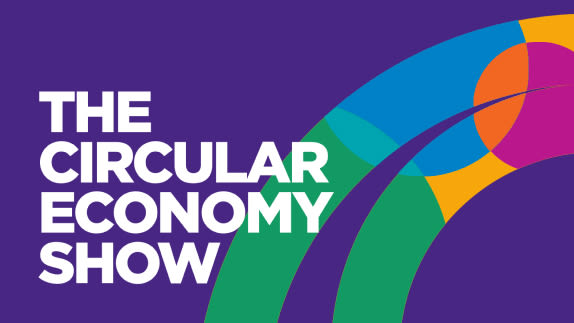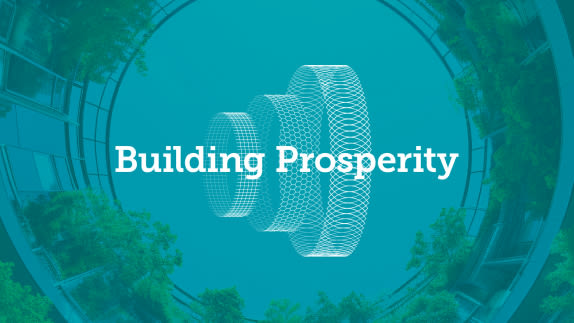Could rethinking our cities through a circular lens be the key to future-proofing Europe whilst offering exciting investment opportunities?
Join us in the third of our five-part Circling Back series of The Circular Economy Show, to hear host Lou Waldegrave speak with Julia Okatz from Systemiq and Joss Bleriot, Executive Lead for Policy and Institutions at the Ellen MacArthur Foundation.
They discuss how circular economy strategies can, by bringing nature back into our built environments, help us adapt to extreme weather—cooling down cities, restoring green space, and building resilience into every street—while generating substantial economic, environmental, and social benefits.
From Paris to Berlin, and cities across the continent, Europe’s urban centres are feeling the effects of heat domes and climate stress. But, the circular economy offers a powerful, nature-positive way forward.
This conversation originally featured in episode 159: How to build a nature-positive circular economy for Europe, published in September 2024.
If you enjoyed this episode, please leave us a review on Apple Podcasts or a comment on Spotify or YouTube. Your support helps us to spread the word about the circular economy.
Transcript
[01:00:00.000] - Emma Elobeid Hot summers, hot cities, and even hotter investment opportunities. That's the topic on the table in today's Look Back episode, the third in our five-part, Circling Back series of The Circular Economy Show.
[01:00:13.560] In today's episode, we're exploring how rethinking our cities through a circular lens could be key to future proofing Europe. Listen in on Lou's conversation with Julia Okatz from Systemiq and Joss Bleriot, Executive Lead Policy and Institutions at the Ellen MacArthur Foundation on how circular economy strategies can, by bringing nature back into our built environments, help us to adapt to extreme weather, cooling down cities, restoring green spaces, and building resilience into every street, all while generating substantial economic, environmental, and social benefits.
[01:00:53.500] - Lou Waldegrave Today, we're discussing the foundation's latest report, Building Prosperity: Unlocking the Potential for a Nature Positive Circular Economy for Europe. Now, the report, forth whith, for the purposes of this podcast to be known as Building Prosperity, explores and illustrates the benefits of a nature and climate-positive circular economy within our cities and built environments.
[01:01:25.220] Joining me today to talk through its findings, I'm thrilled to welcome Julia Okatz, a director from Systemiq, the system change company, which did all the analysis and modelling for the report. A very big welcome, Julia. Thanks for joining us. Also joining me in the studio, is my colleague of 9 and 1 /2 years, the wonderful Joss Bleriot, our Executive Lead for Policy and Institutions here at the foundation. Hi, Joss.
[01:01:54.740] - Joss Bleriot Hi, Lou. It's been that long already.
[01:01:56.620] - Lou Waldegrave Yeah. I know.
[01:01:57.300] - Joss Bleriot Time flies when you're having fun.
[01:01:58.380] - Lou Waldegrave Exactly.
[01:01:59.160] - Joss Bleriot Hi, Julia.
[01:02:00.660] - Lou Waldegrave Thanks for joining me, guys. Joss, let's just get straight in there. When we talk about a nature-positive circular economy, of course, we are referring to the third principle of the circular economy, regenerate nature. This is Probably because the more obvious examples pertain to material circulation and, of course, designing out waste. Was it the report's idea to challenge this?
[01:02:28.240] - Joss Bleriot Yeah, I'm not sure it was exactly challenging it. It was really adding to the narrative and making sure that first we restated the economic opportunity of circular frameworks, and then added a layer of focus when it comes to nature positive implications as well. Because as you rightly say, the most obvious strategies have focused first and foremost on materials management, and the foundation has illustrated the material savings and the economic opportunities of those strategies.
[01:02:57.960] What has been a bit less obvious were the benefits of relying on fewer virgin materials, thereby leaving space for nature to thrive and making sure that we didn't over-exploit, and allowed natural systems to regenerate, and that was the idea with this report, was to say, let's look at this from a principle point of view and adapt it in concrete strategies, investible strategies in the built environment.
[01:03:25.860] - Lou Waldegrave Thank you. Julia, if I can turn to you. For most of us, when you hear the words nature positive, you immediately picture wild lands flourishing or regenerative agriculture. But this report, I beg your pardon, focuses on building biodiversity back into our cities and built environments. What nature-enhancing strategies were identified as key?
[01:03:53.220] - Julia Okatz Thank you, Lou. I think you're absolutely right that when we talk about nature, people tend to think about forests and wild lands and wildflowers, and obviously, those are tremendously important. But there's another dimension that is more intrinsically linked with the built environment and cities. That is important for other reasons. They're also important for biodiversity reasons, but also for the direct, we call it nature-based solutions or ecosystem services that nature delivers to people. It's really about the benefits between nature and people and society that we're looking at here.
[01:04:30.000] Obviously, the built environment is a factor in harming nature, both indirectly through the materials that they procure, but also more directly, just the land that they use. This is less than other sectors, but it's still significant. Very importantly, though, nature is a very important solution, especially in hot summers and hot cities. Nature within cities, and I'm talking about trees in cities, but also nature-based materials, can play an enormous role in making cities liveable, and more sociable and in total, more future-proof. We found that this link is really important to explore. As you just said, there are some strategies that help us improve this relationship very significantly.
[01:05:16.220] You already spoke about six strategies, I believe. Well, anyways, the report talks about six strategies. That's not because we can only do six things. I think we found 60 things by asking amazing experts, reading all the reports I think there are on the topic, and many things we can do. But the point is that often when you have a long list of 60 things, you're a bit overwhelmed. As an investor, as a policymaker, you say, "Okay, starting 60 things at the same time really doesn't work for us."
[01:05:49.560] We were thinking, "Okay, if we had to prioritise, what are six things we can start that make a significant change to the European in this case, right?" European built environment. What we looked at in the end in more detail is three strategies. Of course, they have flashy names because The Ellen MacArthur Foundation is very good at communications. I think they ended up being named Revitalise, Maximise, and Optimise. But what we mean by that is we revitalise assets that we already have to reduce the demand for new assets that then have the big risk of standing empty in the future.
[01:06:30.860] That is very much about pre-used land, so land that we have already sealed or contaminated in a way and can reuse. That is about reusing buildings that for one reason or another are underutilised. I think many people have heard that, especially post-COVID, but also for many other market trends, especially office buildings and certain neighbourhoods do not have the utilisation any more that they should have, financially and from a sustainability point of view. We can remodel, refurbish, reuse quite a few of them.
[01:07:03.380] Then, we also have a lot of space in cities we can reuse for nature, so not only to be built on as in the land, but for nature. We have many parking spots, for example, that are underused or also spots that are called green spaces, but really aren't. That appears green on Google Maps, but really aren't green. We all know those and many other bits and pieces. Often they're a bit smaller and really reusing them strategically for nature places is quite impactful.
[01:07:31.480] Then there's the optimised bit, which maybe people think about more traditionally when they hear circular economy. It's really about the building itself, the structure itself, and how we can optimise that. That is very much about efficiency in the layout and structures. I'm not a structural engineer, but we've talked to many of them and my big thanks to them.
[01:07:50.840] For example, Arup has been amazing in this journey. They obviously know very well what they're talking about when they say, by putting an extra beam in the middle of your room, for example, you can save something like 20%-30% of really hard to abate materials such as cement and steel. That's really significant.
[01:08:09.900] Some people will say a beam in the middle of your room is really annoying. Some will say it's perfectly fine, actually, because it also makes the whole thing cheaper, so there's a lot of win-win in there. Of course, it's about reusing modules and materials in constructing and refurbishing buildings, too.
[01:08:27.180] - Lou Waldegrave Well, thank you. I'm so glad that you guys managed to narrow those down to just the six from 60. Joss, Europe has now led on circular economy policy for the past 10 years. We're entering a new cycle. There's a new commission team about to take office. Is this why the report focused on the EU?
[01:08:51.200] - Joss Bleriot Yes, it is, but also from a pure economic and business perspective, it's important to see that European built environment is about 25 million jobs. It's roughly 10% of European GDP. We could think that it's actually already pretty optimised and pretty high-tech, which it is by certain regards, but we still consume 5.5 tonnes per capita on built environment and construction materials, out of a total of 16 per head in Europe, so that over a third of our material footprint as European citizen lies in construction and built environment, so there's still a lot of optimisation to be done.
[01:09:30.880] Now, to address the EU and the policy perspective, yes, Europe has led for the past 12 years on circular economy policy. We're with the second circular economy action plan at the moment. We also have seen very recently The Nature Restoration Law come into force. It's important to look that under the framework of the EU Green Deal, which tries to look at reconciling the economy with climate ambitions, but also reduction of pollution and wider nature goals, circular economy has a critical role to play.
[01:10:06.840] We take a sector which is very impactful in terms of material consumption that can be optimised. We take the favourable policy context of Europe, and we try to show the gains that can be made by applying those strategies. Of course, Europe already has quite an arsenal when it comes to looking at buildings. There is the strategy for the sustainable built environment of which the renovation wave is part, of which the levels framework is part, so there are already a lot of pockets of policies that can be exploited. We wanted to take a concrete angle and to say, by looking at these strategies, these are the gains and the quantifications that we can make.
[01:10:51.980] At the moment, the next commission isn't completely fully defined yet, but there is a clear mandate to continue with circular economy. There's possibly a circular economy act coming in force as well, so we'll have to wait and see. But what we wanted to do with that report is to bring policymakers, data and insights that give them the confidence to push forward on their circular economy ambitions by proving that this is a sound, future-proof, economic strategy going forward.
[01:11:23.580] - Lou Waldegrave When I read the report, it just filled me with such optimism and positivity when it was pointed out that this can be done. But Julia, today, what have been the key barriers in scaling nature positive solutions in our cities? People like me are sitting there saying, "Surely this is obvious. We have to do it as a matter of urgency."
[01:11:49.620] - Julia Okatz Of course, you're asking the difficult questions, but also the important questions. Yes, so we found there billions, something like 500 billions of benefits for the value chain. Those people who can deliver these solutions, which often are local jobs, high-quality jobs, they're also hundreds of billions of benefits for all sorts of urban stakeholders, be it asset owners or citizens.
[01:12:15.080] As you say, why aren't we doing this at scale? First of all, Europe is doing it in little bits, in little pockets. As you say, it is doable. I think we're talking about examples a little bit later. But in Indeed, it isn't a scaled strategy. It isn't something we see across investment or across policy, really, as a thread. Why not? It is a bit hard to answer in general because all of these strategies are quite different. They need to be implemented by relatively different types of stakeholders. They are different in terms of costs, in terms of investment timelines, and so on.
[01:12:56.600] I think, really, when you want to go deep into it, you should be looking at these levers a little bit more specifically. However, when we talk about, for example, the revitalising nature in cities and also revitalising brownfields as one of the strategy that really has one of the biggest benefits, we see that there's still problems between decision-making and really understanding the strategy. There are problems of valuing, there are problems of capturing the value, so what we would probably call overall as market failures.
[01:13:33.380] First of all, it is actually not quite easy to decide when you have some space or even an abandoned building in a city. Should you reuse that plot for nature? Is that your very direct circular nature strategy? I'll tear this down, whatever it might be, a ruin of an industrial building and put plants here and trees, or should I be using this land to build new, and thereby avoid sprawling and fringe developments around the city and thereby protecting nature outside.
[01:14:03.340] There are some decisions that are just urban planning investment decisions that are not obvious. Usually the answer is, of course, it's neither one nor the other. It's a balance of both. But how to get this balance right, I wouldn't say that there's the one method yet, and people have to think about that a little bit more.
[01:14:22.780] The other thing, though, is even if we say we want to go for a good balance, it's quite hard to value the nature. Basically, what we've done in the report, we've looked at different types of benefits and said, "We can put a dollar, or in this case, a euro number to it," and say, "In a translation to a euro number over a certain number of years, this will save people money. This will benefit them because health costs go down, or they have a better quality of life, therefore, that is more or less worth this many euros," but ultimately, it's very hard to put a price on quality of life, and health, and all of these things. It's even harder to put a number on it that then is investible, that then is tangible for those that have to pay for these solutions.
[01:15:08.660] Even when you do put a number on it, with some front running cities and developers, they do it, and they do it quite successfully, it's still not obvious how to invest in these solutions, and who should pay for them. For example, it could be that the wider public benefits from a park. Should we charge the wider public? Should this be paid through taxes? Or should it be a smaller public that really lives closer to the park, and maybe a small high income, and that is where we capture the value. The real questions, both practical but also normative, in terms of who benefits most, and who should we capture that value from.
[01:15:45.260] - Lou Waldegrave When you guys talk about stakeholders, it's across the board, isn't it? Everyone's involved, business, policymakers, the public. Everyone has a stake in it, how it works, and how it comes about.
[01:16:01.580] - Joss Bleriot Well, everyone does for sure, but one thing pertaining to the barriers that you were asking about, is the system is still optimized for linear material flows, linear thinking. All the underlying economics, are actually about throughput, about volume, about consumption. If we're going to change the models of modular buildings that perhaps change ownership, change purpose, who captures the value? How is that accounted for in simple accountancy terms as well? It's about making the economics work for that new system, and I will refer you back to the Universal Circular Economy Policy goals of the Foundation that we published 3 or 4 years ago.
[01:16:40.300] It's about really looking at the current economic system being hardwired for and by linearity that we also have to challenge. That's when it becomes difficult because we're talking about fiscal policy in some cases. We're talking about ownership models that are not really understood by stakeholders, whether they are finance companies or insurance companies. Then that takes a bit of time.
[01:17:04.280] - Lou Waldegrave Let's end this on a really positive note. What examples from both of you of a nature and climate-positive initiative have you seen already being successfully mobilised in Europe?
[01:17:21.760] - Joss Bleriot I think the most visible ones are the ones that show the transition between the old economy, as we know it, and all the big industrial sites that actually don't really have a purpose any more because we moved on from highly centralised, big projects like gasworks, train depots that perhaps were too big, and you see that across Europe, some pretty cool actually conversions of those sites.
[01:17:50.460] There's a company that I can mention called Jinko based in Switzerland, and they do that in France, in Italy, in Spain, in Portugal. They take those assets, industrial assets, that were rendered obsolete and turn them into either commercial or residential properties. They're in the process of doing that over 1 million square kilometres. It shows actually that there's a lot of business opportunity in this because already the company has returned three times the equity that was invested in it.
[01:18:21.660] The beauty of all that is the built environment is really cross-sector. Whether you produce jewellery, or you sell data, you have a built environment footprint. This report and the opportunities are not only directed at the construction sector. Everybody can implement a bit of the strategies that we highlight.
[01:18:41.800] - Lou Waldegrave Thank you. Have you got anything to add to that, Julia, or are you with Joss on Jinko?
[01:18:47.940] - Julia Okatz I'm absolutely with Joss on Jinko and also a few others that do amazing work here. I think what's interesting about these examples is that we see that a lot of the strategies that we analyse, even though they are quite different, in the end, it's often the same players that implement them together. Really, when you implement them together, they seem to cross-fertilize or support each other.
[01:19:10.500] Take, for example, we revitalise a whole industrial area. Yes, you can do that for property. Then, yes, you can do it in a more circular way because you're revitalising something. That means you have some old soil or some old buildings that you can then reuse, and it's at scale, so you can reuse it a little bit more flexibly. You can say, "Oh, this stone fits best for X structure. Because I have a diverse development, I can reuse that better." That is much easier, not to say it's easy, but easier than in smaller scale developments, because then probably what you had before doesn't fit your new piece.
[01:19:46.640] Same for nature. If you have that space, and that scale, and that integrated thinking, and you integrate a park, and indeed, Jinko, again, they do a lot of nature restoration on their sites, too, you can actually capture some financial value from that because you also own or develop the real estate around it. It's a bit easier to connect the value of these things.
[01:20:10.340] I think it's quite important to look for examples and inspiration that think through these strategies in an integrated way. The beauty of it that we do have these examples, not only in the private field, also in the public. I think it's important also to underline that some cities are doing incredible work with this. Copenhagen, for example, or Ljubljana. I think one that we should always mention that's not in Europe, but it's just the poster child and the star of this, which is Medellín in Colombia, which has done really impressive work on this front. I think when we look at these examples, I think, as you said, Lou, we should hopefully be inspired to see that it's possible and that we can adopt it at scale.
[01:20:57.800] - Lou Waldegrave Well, I've definitely been inspired. To anyone out there or whoever is listening, read the report because it is so positive, and it is such a great way forward. Joss, Julia, thank you so much for joining me today and taking us through it. Really appreciate it.
[01:21:18.160] - Joss Bleriot Thanks, Lou, and thanks to the whole Systemiq team. It was really a pleasure to work with you guys on this again.
[01:21:25.620] - Emma Elobeid From Paris to Berlin and cities across the continent, Europe's urban centres are feeling the effects of heat domes and climate stress. But as we've just heard there, the circular economy offers a powerful nature-positive way forward. These are more than just climate strategies. They're economic opportunities. Circular solutions are hot to go for businesses, governments, and investors alike. Hope you're enjoying the series so far.
Don't forget to leave a review or tag us on social. We'd love to hear what's resonating.
I'll see you next time when we head east to explore how China is bringing circular strategies into climate action.





